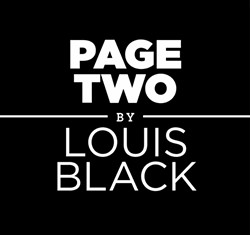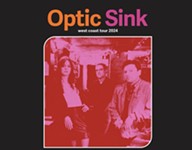Page Two
'Sin City' may offer almost no suggestion of a moral substructure. But it insists there is morality, no matter how fragmented.
By Louis Black, Fri., April 15, 2005

How a movie makes meaning for an audience (how it is "read," or understood – how it is consciously and emotionally taken in by viewers) is widely discussed and argued over. Whether this is a complicated or quite simple interaction is even debated.
Part of this is the nature of the current critical environment: a unique combination of high-art culture pedants and the modern American know-nothing-and-proud-of-it movement that subscribes to the belief that most movies are simply entertainment and nothing more. In most cases, this is exactly how regular daily film reviewers are expected to, and do, treat them: Is watching the film entertaining? Does it achieve its goals, and are they worthy goals? Is it powerful, funny, and enlightening, or is it sophomoric and stupid? Those are their questions; they are talking to you primarily about the quality of an evening's entertainment.
All objects of culture are loaded with meaning about the culture. This doesn't mean they are designed to be important or that George Lucas intends the Star Wars films to detail a complex theology. A pet rock gives us information about the culture in which it becomes a fad, as do hula hoops and tattoos. Films are loaded with meaning, intended and unintended. If you think that's ridiculous, you're right, and can stop reading now. I really mean that: I want to offer ideas without addressing often-ridiculous counterarguments. In general, the ongoing discussion is the point; there is no discernible "truth," so arguments are welcome when they're beyond the point of exasperated explosions of "Now, you don't really think the filmmaker intended that, do you!?" Trust the tale, not the teller, and any kind of cultural speculation is at best just thinking. There is no argument for or suggestion of intentionality. There is an assumption that, unintentionally, all products of a culture are loaded with meaning.
Robert Rodriguez's Sin City has been discussed by all reviewers – friendly, critical, and horrified alike – in terms of its style, excessive violence, gore, cinematic vitality, brutality, portrayal of women, and as an action-movie experience. A favorable Web review offered, "Sin City has more severed heads, dismemberments and cannibalism themes than The Silence of the Lambs and Freddy Vs. Jason put together. I loved it!" While a small city daily's negative review offered, "You know [you've] gone beyond run-of-the-mill movie violence [when] you need to use the plural for 'castrations.'" One friend e-mailed me that he wanted to take a shower after seeing it, while my son (who is extremely, one might say excessively, critical) announced that it was the best action film he'd ever seen, going on to extol its cinematic virtues. Many reviews, in addition to discussing the graphic-novel and comic-book visual treatment, also mention film noir, where this film has its positive roots.
Obviously, there are many legitimate readings of this film, but this is about the way I watch movies. When I got over the stunningly brilliant style and visceral cinematic experience, I realized, at its center, Sin City is a classic morality tale more than anything else, almost reactionary in its thematic conceits: more prenoir – if we take that to mean the work of Raymond Chandler and Dashiell Hammett – than the films that generated the term.
What everybody seems to be missing in Rodriguez's brilliant cinematic evocation of the novels is Frank Miller's howling, Old Testament morality! A sense of extraordinary outrage at moral corruption coupled with a bizarre optimism about the ability of the individual to triumph.
What? Have I gone insane?! A film about hookers, cannibalism, killers, corrupt cops, politicians, and religious leaders is in any way moral? Come on, one could argue, this is a film with lesbian killer prostitutes, extreme sexual perverts, and constant acts of random and extreme violence in which, in fact, there is no moral center!
Exactly! As Henry Miller wrote, once you've given up the ghost, everything else follows with dead certainty, even in the midst of chaos. Accept Sin City as what it claims to be: the metaphoric evocation of the worst aspects of humans in general and modern life in particular. This is not a lovingly detailed celebration of sadism, perversion, and violence. They are invoked as representing pure evil. The art in both Miller's books and the film is very consciously much more evocative than specifically graphic. Far more of the frame is left shaded than is illustrated, and the illustrations are often more suggestive than representative.
Miller and Rodriguez are taking us to the ugliest section of the ugliest world imaginable. That's the damn setting! I'm not saying there aren't lots of folks loving the brutality, sadism, and misogyny. But the movie is arguing against those: Sure, putrid evil is attractive, and adding nuanced detail in terms of a gesture, a thought, an accoutrement, or expression is black-comedic perversity. There is a side of the film that celebrates the very seedy world it protests. But there is also, and more importantly, another side.
As much as anything, Sin City's world is a critique of our world – the more casual hypocrisy, corruption, viciousness, privileged class system, and injustice of the everyday magnified into near insensibility. I'm not arguing for comparisons to Dickens or Dostoyevsky, but remember the reaction that greeted some of their work decried their graphic depravity.
Miller is imagining, not celebrating; he is horrified, not delighted, by this world. Beyond style and affectation, what this film is about how human decency flourishes in the most inhumane, inhospitable circumstances, often flourishing within the most unlikely people – unlikely in view of the kinds of characters they are portrayed to be. Even more unlikely when one considers the nature of heroes and antiheroes in traditional narratives.
The first shot of Orson Welles' character in Touch of Evil is a low-angle shot that defines ugly. It's not just the size of Welles' body or how unattractive a man he is, but that you can sense the self-satisfied moral corruption oozing out of his body like sweat. In Miller's world, he would be a hero.
Antiheroes can be contradictory, but rarely are they as outside as Miller and Rodriguez depict them. A lot of reviewers cite Mickey Spillane in discussing Sin City. Although his novels were a source of some of the action styling (especially the film version of Kiss Me Deadly, directed by Robert Aldrich, who found the novel repulsive), Spillane is the nihilistic dead end of film noir. There is no moral center; there is no right or wrong; there is no justice and injustice, only action and inaction. The world is the enemy; everything is ugly.
Traditionally, noir depicts a rotting part of a city or a corrupted community, with a more normal world functioning somewhere around it. Sin City is of and unto itself; there is precious little of any other world suggested. The corruption and rottenness soak this city to its core. Yet redemption is possible!
It was no surprise that, when talking to Miller at dinner before the AFS benefit screening of Sin City, as soon as I mentioned Sam Peckinpah's The Wild Bunch, his eyes lit up as he said, "Let's go!"
At the very end of the movie, after a night spent (by some of them) with whores, four of the surviving members of the Wild Bunch face the morning. The Mexican general for whom they have stolen guns is brutally torturing Angel, one of the gang, because he took some of the guns to give to villagers. When the general grabbed him, there was nothing that the Bunch could do, because he was backed up by his substantial and well-armed troops.
Now it's morning. They come out into the sun; Pike (William Holden) says, "Let's go!"
Sitting on the ground is Warren Oates' Lyle Gorch, seemingly the least sympathetic to Angel, who spits out, "Why not!"
Then the four walk down the street to face the general and his army.
This is about honor, self-respect, and the value of one's word, which is the value of one's worth. It offers the audacious and truly liberating metaphorical assertion that we are always free if we can choose how we will die and for what. There are a lot of ways to trivialize that statement and to act aghast at it, but think of its bolder meaning. Certainly, there are restrictions on our freedoms, many of them beneficial: those that come from friendship, family, partners, jobs, and living in a community. Those who veer away from any restriction and too far toward freedom are often offensively obnoxious and counterproductive, as so often was Peckinpah.
So the idea is not just to live free. The film is not saying the only way to live free is to choose how you die. The Peckinpah family motto was "To enter one's house justified." It is about living your life to be worthy of it. It is saying that in the worst possible circumstances, under the most prohibitive restrictions, redemption is possible. Choosing how one dies is an option for living up to one's word.
Setting these ideas in the most violent of settings may not be your idea of a poetic or insightful cultural work. The world is what it is and has become. Again, this might not be the kind of work you can embrace. But in a world after Hitler, Stalin, and Mao, after the Korean and Vietnam wars, in a world of psychotic terrorists, self-righteous religious zealots, genetic cleansing, deliberate genocide, nuclear bombs, poison gases, and biological weapons, to suggest this film is overly violent is to ignore or trivialize the obvious.
In the most dark, impossible setting, with nightmare vision, the dramatics of Grand Guignol, the aesthetics of the theatre of cruelty, and the outward optimism of a debilitated, diseased criminal sentenced to death, Miller and Rodriguez, again and again, find humanity. In the way the whores are together, certain characters support each other, and some people stick by their word is a new heroics firmly rooted in morality, even if every defining or even suggesting characteristic has changed. I offer this not as a justification but an aesthetic explanation. In a shocked world, you have to go fairly far to shock. I suggest no noble purpose for Miller or Rodriguez, but an intuitive aesthetic sense.
Popular culture – comic books, movies, television shows, pulp novels, etc. – has always been an important way of making sense of the world, my place in it, and its organizing sensibilities/possibilities. Religion, philosophy, school, and family have certainly all contributed, but popular culture has an ongoing ability to refine complex situations and confusing, shifting priorities and standards into accessible narratives. By no means am I suggesting conscious wisdom, specific descriptions, or analytic options. Since we began telling each other stories and drawing on cave walls, narratives have not just entertained us but also educated us, in the broadest sense of the word.
At the end of the day (or the movie and novels), Sin City may offer almost no light or suggestion of a moral substructure. But it insists there is morality, no matter how fragmented. In the most corrupted of situations, under the most perverted and distorted conditions, against all the odds, basic human decency can triumph. And in that glow, there is all hope. ![]()








